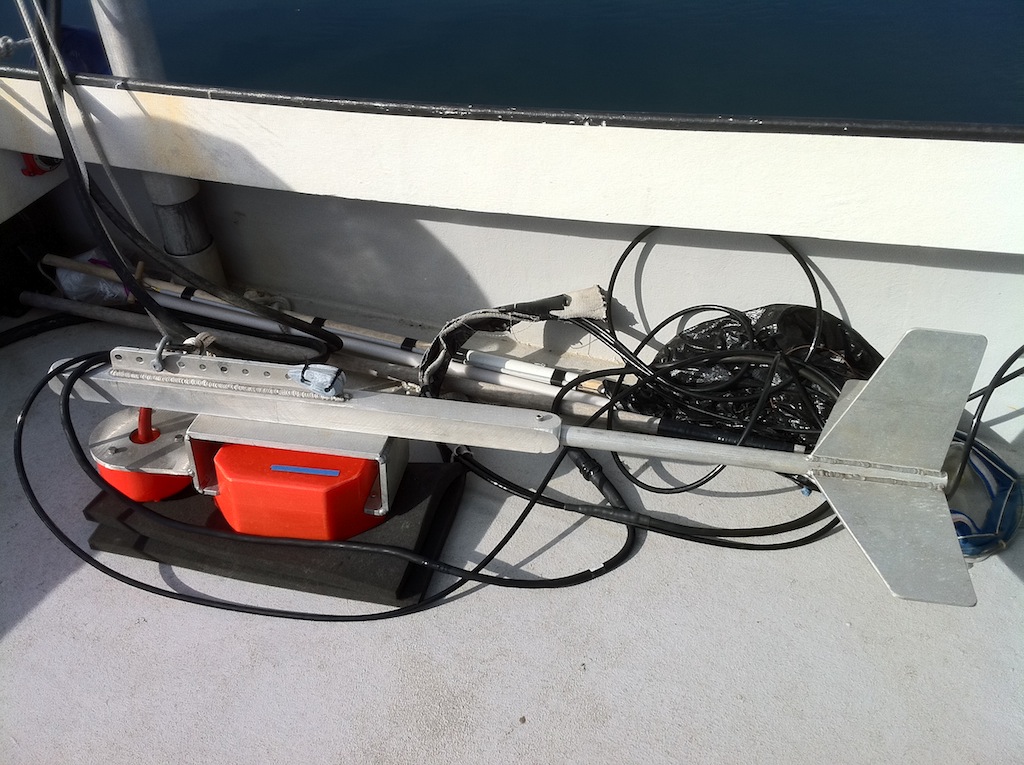Just another day of fieldwork in the Long Eddy….

The weather was great from Tuesday through Friday, calm seas, light wind, and sun, but then took a turn for the worse to more typical Grand Manan weather…wind and fog. It was blowing a good 25 knots on Saturday, keeping us onshore, but Sunday morning, we awoke to no wind and fog. These conditions weren’t good for the tagging boat because they need calm weather and clear skies to spot whales, but the prey mapping boat can operate in fog since what we are looking for is all below the ocean’s surface. We decided to make the most of the weather and head out to calibrate the echosounder. We went to a more protected area on the eastern side of Grand Manan and tied up our boat. We then hung a perfectly rounded sphere of known sound backscattering strength under each frequency of the echosounder (38 and 120 kHz). We moved the sphere around attempting to cover the entire beam of the echosounder and recorded data during this process.
[photo size=’medium’ align=’right’ title=’Here’s an image of the final product. Red dots are where the values for backscattering strength of the sphere are above expectations, and blue dots are values below expectations. The green dots are those closest to the center axis.’ link=’http://superpod.ml.duke.edu/johnston/files/2011/09/Screen-shot-2011-09-05-at-12.30.51-PM.png’ icon=’zoom’ lightbox=’image’]http://superpod.ml.duke.edu/johnston/files/2011/09/Screen-shot-2011-09-05-at-12.30.51-PM.png[/photo]Things went surprisingly smoothly during the calibration, in large part because TJ and I had done a practice calibration at the dock the day before. Of course, the day wouldn’t have been complete without some type of echosounder malfunction. Just as we were finishing up calibration of the 120 kHz echosounder, the program decided to crash and we had to redo the calibration. We did prevail in the end though, completing a quick second calibration just as the fog had burned off.The tagging team met us out on the water and began to search for whales during flood tide in the afternoon. We (prey sampling team) began to run line transects. In the eddy Conditions weren’t as nice as they were the week prior, and it was quite challenging to deploy the towfish (that’s what we call the device we with the echosounder in it, see the picture of it on the deck of the boat) as we were rocking and rolling broadside to the chop in our small boat. We managed to survey three lines before we called it a day. The tagging boat was unsuccessful in finding a fin whale, and only saw two minke whales and a handful of porpoise all afternoon. We do always have bird sightings, and the Greater Shearwater is the most common bird we see while we are sampling in the eddy.
[photo size=’large’ title=’Greater Shearwater’ link=’http://superpod.ml.duke.edu/johnston/files/2011/09/Xx_20110904_S6_C-IMG578151.jpeg’ icon=’zoom’ lightbox=’image’]http://superpod.ml.duke.edu/johnston/files/2011/09/Xx_20110904_S6_C-IMG578151.jpeg[/photo] Our lack of fin whale sightings was a reminder that despite working in a very predictable system (regular tides, prey aggregations, and marine mammal predators), unlike physics, animals are unpredictable and are not always around when you expect them to be. [photo size=’medium’ align=’right’ title=’Brrr’ link=’http://superpod.ml.duke.edu/johnston/files/2011/09/Xx_20110904_S6_C-IMG5787.jpeg’ icon=’zoom’ lightbox=’image’]http://superpod.ml.duke.edu/johnston/files/2011/09/Xx_20110904_S6_C-IMG5787.jpeg[/photo]I would have to say what might be the most exciting thing that happened all day was when we got a call on the radio that Jerry, our new whale tagger, had unintentionally taken a swim in the cold waters of the Bay of Fundy. According to Jerry, he was trying to rescue a baby harbor porpoise who was stuck in a bucket, all the while fighting off a killer whale who was trying to have the porpoise calf for diner…but we all know what really happened. He was in fact doing a good deed by collecting trash from the Bay – a bucket. The bucket, to his surprise, was filled with water and was heavier than he expected and simply pulled him over the side. He did manage to hang onto the boat, so was able to swing himself back in fairly quickly, but not before his self-inflating life jacket went off.
We wrapped up the evening with a delicious dinner with old and new friends at the Grand Manan Whale and Seabird Research Station. Stories were told of when our advisors (Dave Johnston, Heather Koopman, and Andrew Westgate) were graduate students patrolling the herring weirs for trapped harbor porpoise and drinks were shared among many. All in all, just another day of fieldwork in the Long Eddy….with many new stories in the making.
